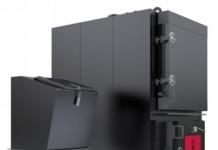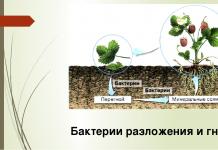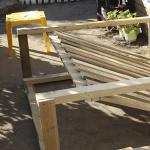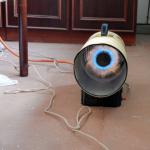Boilers for sawdust, wood chips and wood waste
5 (100%) votes: 2Today we want to consider solid fuel boilers for wood chips and sawdust with automatic fuel supply using the Russian-made models of the popular Pyrolysis Master brand as an example. The manufacturer produces 2 series of boilers for wood chips and sawdust - boilers of the BIO series for heating houses with an area of 100 square meters and industrial boilers of the BIO VULKAN PRO series for heating industries, greenhouse complexes, for generating thermal energy in the housing and communal services sector.
Model range tables
So, here are tables of models, main characteristics and prices at which you can buy a boiler model that suits you.
You can find out the price and buy heating equipment and related products from us. Write, call and come to one of the stores in your city. Delivery across all territory of the Russian Federation and the CIS countries.
| Model | power, kWt | Area, up to m² | price, rub. |
|---|---|---|---|
| 100 | 1000 | 662 600 | |
| 160 | 1600 | 696 200 | |
| 200 | 2000 | 722 900 | |
| 250 | 2500 | 865 600 | |
| 320 | 3200 | 1 083 600 | |
| 400 | 4000 | 1 143 600 | |
| 500 | 5000 | 1 219 600 | |
| 600 | 6000 | 1 488 600 | |
| 750 | 7500 | 1 595 600 | |
| 850 | 8500 | 1 780 600 | |
| BIO VULKAN PRO-1000 | 1000 | 1000 | 1 990 600 |
Among the manufacturers of industrial boilers for wood chips and sawdust, it is worth noting the domestic company Pyrolysis Master and its BIO VULKAN PRO 100-1000 kW series.

Industrial boiler for wood chips and sawdust Pyrolysis Master BIO VULKAN PRO
With their help, you can heat domestic, industrial and other premises, prepare heat for technical needs.
The boilers are equipped with a mechanical supply system for wood chips and sawdust into the combustion chamber.
Fuel fraction - 40 mm, humidity - up to 50%.
The maximum hot water temperature is 110 ºC.
If necessary, manually loaded firewood, coal, manually loaded briquettes can be used as fuel, but the power will decrease by 15 - 20%.
Boiler device Pyrolysis Master BIO VULKAN PRO
Among the features of solid fuel boilers BIO VULKAN PRO we note the following:

In the ash pan Pyrolysis Master BIO VULKAN PRO, under the grates, there is a fuel supply chute, a screw conveyor of the boiler is mounted in it, with the help of which, along the “volcano”, between the grates, and a frame made of heat-resistant concrete slabs, reinforced by a supporting structure, mechanized bulk fuel is supplied.
The flame of burning fuel heats the fireclay plates of the furnace, its inner walls and the bottom of the drum, and the resulting hot combustion products pass through the heating pipes of the heat exchanger so that, giving off heat to the circulating water, they cool down and are removed from the boiler through the chimney.
Boilers for sawdust, husks, wood chips, peat, pellets of the BIO series 15-500 kW.
| Model | power, kWt | Area, up to m² | price, rub. |
|---|---|---|---|
| BIO-15 | 15 | 150 | 185 000 |
| BIO-20 | 20 | 200 | 190 000 |
| BIO-30 | 30 | 300 | 210 000 |
| BIO-40 | 40 | 400 | 225 000 |
| BIO-50 | 50 | 50 | 265 000 |
| BIO-60 | 60 | 600 | 294 000 |
| BIO-80 | 80 | 800 | 357 000 |
| BIO-100 | 100 | 1000 | 420 000 |
| BIO-120 | 120 | 1200 | 483 000 |
| BIO-160 | 16 | 1600 | 555 000 |
| BIO-200 | 200 | 2000 | 621 000 |
| BIO-250 | 250 | 2500 | 667 000 |
| BIO-320 | 320 | 3200 | 930 000 |
| BIO-400 | 400 | 4000 | 1 380 000 |
| BIO-500 | 500 | 500 | 1 610 000 |

Pyrolysis master BIO
The basic package of the BIO boiler includes:
- body of a biomass heating boiler;
- base fuel bunker for biomass;
- screw conveyor;
- burner;
- fan;
- automatic control unit.
If desired, the bunker can be enlarged, the boiler can be equipped with automatic burner cleaning, GSM and WiFi modules.
The Pyrolysis Master boilers of the BIO series are distinguished by the presence of a 5-way heat exchanger. As a result, the boilers are characterized by the highest efficiency when compared with boilers that have 2-3 strokes in the convective furnace channels.
Biomass is burned using a horizontal type retort burner. This allows you to burn pellets in any quality, sawdust, wood chips with a fraction of up to 4 cm, oilseed husks, peat.
Automation, electronics and fans are presented by the best European manufacturers.
From the tables above, you can see that this is the richest assortment of boilers for wood chips and sawdust, among all manufacturers on the Russian market. Such a set of power options will allow solving the problem of heating on wood chips and sawdust at any objects and for any area.
Principle of operation
Now consider the general arrangement of boilers for wood chips and sawdust.
The body of the device consists of the following elements:
- firebox;
- ash pan;
- coil;
- chimney;
- blew;
- heat distributor;
- sensors.

Boiler device Hargassner
In the furnace, on a special grate, the process of burning wood chips and sawdust takes place, thanks to which all the ashes and ash remain in the ash pan. Cleaning of this device should be done about 2 times a month.
Due to the fact that chips and sawdust are woodworking waste and do not form a large flame, the heat exchanger in such boilers is heated by hot gases passing through it.
The heat exchanger consists of tubes that are connected in parallel. It is made of a material that can withstand high temperatures well and does not rust, and it also has such a quality as a high level of thermal conductivity.
Sawdust and wood chips are a particularly economical type of fuel if there is a source of fuel nearby: woodworking.

Wood chip boiler Hargassner WTH 150-200
To achieve higher productivity, gas-fired heating boilers on wood chips and sawdust are used, the heating of which occurs not only due to the heat from fuel combustion, but also due to the pyrolysis gas released during the combustion of wood.
In order for the gas to be burned, the boiler furnace consists of two separate chambers. In one, the fuel itself burns, in the other, the gas coming from the first chamber burns.
Boilers for heating, operating on sawdust and wood chips, like other heating appliances, are single-circuit and double-circuit.
The former are designed exclusively for space heating, the latter are also capable of heating water. Such units are in demand among owners of private houses, because. allow not only to provide the house with heat, but also to equip the water supply in the house.
The efficiency of boilers operating on sawdust and wood chips is about 90%.
Fuel supply system
Solid fuel boilers for long burning on wood chips and sawdust, operating offline, require virtually no maintenance.
Fuel is supplied through several conveyors:
- Successor - the bunker has free access outside the building. It has an auger transmission, which is connected to the main storage. After the fuel is loaded into the bunker, the conveyor is turned on, which supplies the fuel to the mechanized storage.
- There are two types of storage, with different ways of supplying wood chips to the boiler. In the first case, an inclined base acts as a bunker, which forms a cone, at the bottom of which there is a screw transmission. The second uses an agitator with blades connected to it. During the rotation of the device, the chips fall into the auger.
- After storage, wood chips do not enter the boiler immediately. Pyrolysis heating water boilers, operating on sawdust and wood chips, supply fuel in parts. Each new portion of fuel enters the furnace using a special drum, which is connected to a screw transmission that feeds chips to the burner.

System for loading fuel from a fuel storage using a horizontal spring agitator with a lifting screw conveyor for HERZ firematic 20-301 and HERZ BioMatic 220-500 boilers
Advantages and disadvantages
Like any other heating device, solid fuel boilers have their pros and cons. Most of the shortcomings are associated with the type of fuel - wood chips. It has low bulk properties, due to which it is difficult to transport it. Chips and sawdust are characterized by high humidity, which is why they burn worse than wood or.

Wood chip and pellet boiler Termal SF
However, despite a number of negative points, there are also positive aspects of such devices:
- inexpensive fuel, because waste is used as it;
- thanks to the absolute automation of the operation of solid fuel boilers, they can function even if there are no people in the house;
- all wood fuel is environmentally friendly, so there will be no harm to the environment;
- high efficiency (90% or more);
- they are economical, on one load of fuel they can heat the room for 10-12 hours;
- heating occurs quickly, 30-40 minutes after ignition;
- The design of such devices is simple, but at the same time reliable.
On the market you can find various options for such boilers from foreign ones (for example, Termal, Faci, HERZ, Hargassner) and Russian manufacturers (for example, Zota).
Therefore, it is worth taking a closer look at sawdust and other woodworking waste.
Sawdust boilers are increasingly being used in hot water heating systems as a heat source. This is due to the many benefits they offer. Boilers work on wood chips and sawdust, therefore they are highly environmentally friendly. This option helps to save money, especially when making the unit yourself. They have sufficient power to maintain heat in residential and industrial premises with a large area.
Due to the high price of classic energy carriers and its constant growth, homeowners are switching to more budget options. The cheapest types of fuel are wood chips and sawdust. And if you make a boiler from simple and affordable materials, you get a fairly practical solution. If it is problematic to do welding work yourself, you can invite a professional welder.
Features of the operation of boilers
The most modern and reliable type of sawdust boilers are automated water heating systems. Their design consists of several main parts:
- fuel bunker;
- gas generator;
- hot water boiler - consists of a combustion chamber and a heat exchanger;
- automatic control system.
The body structure includes the following elements:
- firebox;
- chimney;
- ash pan;
- heat distributor;
- coil;
- blew;
- sensors.
Depending on the design of the building, it can be installed completely indoors, outdoors, or partially outdoors.

The automatic system is responsible for the following operations:
- supply of wood chips to the boiler;
- the flow of hot air into the combustion chamber in accordance with the volume of fuel;
- temperature control;
- firefighting.
Among the imported boilers of a similar device, Austrian HARGASSNER can be distinguished. They are especially popular in Europe for heating hotels, houses, office buildings.

A bright representative of domestic boilers is BIO VULKAN manufactured by Pyrolysis Master. The main features of these devices:
- The body of the firebox is made up of steel sheets and pipes, covered with heat-insulating material on the outside.
- Fireclay bricks are laid inside - this increases the heating temperature.
- Sealed doors with concrete body, large and heat resistant.
- Fans supply primary and secondary air to the furnace - this is necessary for combustion.
- The drum heat exchanger is protected from lime deposits by two-level water circulation.
These sawdust boilers are characterized by the highest efficiency, which is associated with the installation of a five-way heat exchanger on them. For fuel combustion, a retort burner is used, which allows the use of wood waste with a fraction of up to 4 cm.
Fuel feed mechanism
Boilers for heating on solid fuels operate autonomously and can be dispensed with with little or no maintenance. Sawdust is fed by several means.
The receiver has open access to the outside of the building. It is equipped with a screw transmission connected to the storage. When the bunker is fully loaded with fuel, the conveyor starts working - it supplies fuel to the mechanized compartment.
There are two types of storage, they differ in the technique of feeding sawdust into the boiler:
- hopper with an inclined base, cone-shaped, with a screw mechanism in the lower part;
- agitator with blades, sawdust is loaded by rotation.

From storage, not all fuel enters the furnace immediately. Pyrolysis type wood chip boilers are equipped with a drum and a screw transmission, which supply fuel in parts.
Self-manufacturing of boilers
When a house needs a device for heating, but you don’t want to spend a significant amount of money on buying it, you can make it yourself. For this you will need:
- pipes with a round profile 4-5 cm in diameter;
- rectangular pipes 60X40 mm;
- welding machine;
- electrodes;
- Grinder.
Pipes are selected so that they fit in a boiler measuring 36x40x80 cm. Structures with a rectangular section will serve as vertical racks. Round holes are created in them for attaching other elements of the device.
Pipelines 5 cm in diameter will be located on the wall of the boiler with a door. For the back, you need the first four rectangles measuring 5x6 cm, and the next - 4x4 cm.
Holes 5 cm in diameter are cut out for connecting pipes. Cold and hot water will flow through them.
Manufacturing process
The front and rear parts of the boiler are equipped as follows:
- rectangular racks are attached by welding;
- round pipes are installed perpendicular to them;
- pipelines for water supply and drainage are connected;
- the open ends of the pipes are closed with parts of metal sheets and welded.

The boiler is checked for leaks - water is poured into the pipes in order to immediately detect a leak. If everything is in order, the device is mounted in a brick firebox. You can make it yourself using refractory materials for this.
Principle of operation
The boiler is loaded with fuel from above, from the bottom to the chimney cut. It has no doors or ash pan. Chips and sawdust are compacted with a special weight made of a thick sheet of steel. A pipe is welded to it, through which air is supplied to the furnace. It passes vertically through the lid, its end comes out - the boiler is ignited through it.
The meaning is to burn the top layer of biomass, the whole process moves downward. This is how the water jacket is heated.
A damper is mounted at the end of the pipe - with its help, the air supply is regulated in order to control the rate of combustion of the fuel. In the process of work, sawdust becomes less and less, the load falls lower until the boiler is empty. It is released from combustion products through the chimney.
When making it yourself, you must definitely use the drawings - it's easier to figure out the proportions and shape of the parts. For the device to function properly, it must be properly assembled.
Advantages and disadvantages of sawdust boilers
Any type of heating equipment has its pros and cons. The disadvantages of a sawdust boiler are related to the quality of the fuel. Sawdust has poor flowability, because of this there are difficulties with transportation. In addition, they tend to absorb moisture, so they will burn worse than wood and coal. Home-made devices do not have any guarantees for the quality of welds, their appearance is very different from their production counterparts in their unsightliness.
But, nevertheless, the device also has positive qualities:
- profitability (compared to other types of fuel, since sawdust is construction waste);
- high efficiency - more than 90%;
- works without harm to the environment, sawdust is an environmentally friendly product;
- one load of fuel can heat the house up to 10-12 hours;
- fast heating - 30 minutes after starting;
- simple design.
The cost of a home-made sawdust boiler will be several times lower than a branded one, even if you buy all the materials for its manufacture in a store and hire a professional welder. And if some details are found on the farm, the savings will be even greater.
Such boilers are picky about fuel and its quality, unlike factory ones. There will be chips from pine or birch - it doesn’t matter, the resin emitted will not harm the device.
Main- so that attempts to save money do not bring big losses: a do-it-yourself boiler does not meet safety requirements. It is not durable and reliable, it lacks automatic control systems, so you cannot leave it unattended.
Video: Drawings of a homemade sawdust boiler
sawdust - lovely material for heating houses and greenhouses.
They consist of wood, which means that when used correctly, they are only slightly inferior in terms of heat capacity to firewood.
You can get them cheap, and in some cases even for free.
- houses;
- makeshift;
- greenhouses.
We will also consider in detail all types of heating stoves and long-burning boilers that can use sawdust as fuel.
 Before talking about the features of boiler houses on sawdust, you need to deal with yourself combustion mechanism this fuel, because it is very different from the mechanism of burning wood.
Before talking about the features of boiler houses on sawdust, you need to deal with yourself combustion mechanism this fuel, because it is very different from the mechanism of burning wood.
No matter how tightly the firewood is stacked, between them there is always air passes, and in sufficient quantity to support combustion.
Even loosely laid sawdust skips much less air, so the smoldering quickly dies out without supplying additional air to the combustion zone.
Sawdust burners work effectively only when fire moves from top to bottom. Therefore, only a layer of sawdust 2–5 cm thick is constantly burning.
Due to the fact that only a small amount of fuel is involved in combustion, power boilers on sawdust and stoves working on them, with the same with wood and coal heating appliances 2-3 times less.
Another factor that reduces the power of the boiler or furnace is the low combustion temperature of sawdust.
If firewood burns with the right air supply, then the flame temperature exceeds 1000 degrees, often reaching 2000 degrees in tongues of fire. And this powerful fire, because the whole mass of firewood emits pyrolysis gases.
The temperature of the fire near burning sawdust, even with the right air supply, does not always reach and 1000 degrees because of low flow of pyrolysis gases.
Pyrolysis gases effectively exit only from the upper layer with a thickness 5–15 mm.
 From sawdust that is burning or heated, but located below, the gas escapes with difficulty, because the sawdust located on top interferes with it.
From sawdust that is burning or heated, but located below, the gas escapes with difficulty, because the sawdust located on top interferes with it.
Despite these shortcomings, sawdust perfect fit for boilers and long-burning furnaces.
After all, well-compacted sawdust burns a very long time.
Often, a home-made iron stove burns for 5–8 days from one filing of sawdust, providing heating for the entire house.
Suitable heating systems
For heating with sawdust of private houses and any buildings use such systems:
- heating stoves;
- heating furnaces with a water heating register or heater;
- water heating with radiators;
- water heated floor;
- air heating;
- air heated floor.
Heating stoves heat space around you and therefore only suitable for small houses. At a distance of 10 meters from the stove, the temperature drops by 10-15 degrees, so in large houses the stove can only act as an additional heater.
Heating furnaces with water heating register or heater combine the advantages of furnaces and boilers. They give the same heat as a conventional heating stove and heat the coolant, which enters remote rooms through pipes or air ducts.

The large mass of the furnace turns it into heat accumulator, thanks to which you do not have to re-heat the boiler every 2 hours or throw firewood into it every hour. The oven will maintain temperature coolant up to 6–10 hours, so you can heat 2-3 times a day.
Water heating with radiators in each room can be used with both a water boiler and a sawdust stove if it is built into it. water register. Like any other water heating, it can work on natural or forced circulation of the coolant.
In systems with natural circulation hot water first rises to the ceiling, then descends into each room and enters either radiators or underfloor heating. In systems with forced circulation water is driven by a pump, so all pipes can be laid under the floor.
Water and air underfloor heating not only heats the room, but also improves its microclimate. In winter, it is very pleasant to walk barefoot on the floor, feeling its warmth with your feet. Main lack of underfloor heating- the high cost of materials and work, because it is necessary not only to lay air ducts or a water pipe, but also to qualitatively insulate the space between the floor and the ground or foundation.
Air heating also costs expensive, as well as a warm floor, because it is necessary to lay air ducts throughout the house, as well as put automatic humidifiers due to the strong drying of the air. A furnace with a heater can be used as a heat source.
 The difference between furnaces and boilers is only in the presence of a boiler water jacket, that is, the space between the hot body and the outer casing is filled with water.
The difference between furnaces and boilers is only in the presence of a boiler water jacket, that is, the space between the hot body and the outer casing is filled with water.
Here distinctive features each heater:
- bake– direct heating of air and surrounding space;
- heater– air heating for delivery to other rooms without heating the surrounding space;
- furnace-heater- heating of the surrounding space and heating of air for delivery to other rooms;
- oven with register– heating of the surrounding space and water for delivery to other rooms;
- boiler– heating water for delivery to other rooms.
Therefore, heaters and boilers are installed in utility rooms and often insulated from the outside. After all, it makes no sense to spend thermal energy on strong heating of the utility room, and the less heat is spent on this, the more other rooms will get.
Requirements for heating appliances
For heating with sawdust, it is necessary to use long-burning boilers and stoves that comply with the following conditions:
- fuel combustion top down;
- big outer surface area(important for ovens);
- big heat exchanger area or water jacket;
- big firebox volume;
- opportunity air supply into the combustion zone.

Due to the small size of the sawdust, it can be fed into the furnace or boiler automatically, which is even more increases battery life heating device. Most often, auger feed is used for this - a rotating auger raises or lowers sawdust from the bunker and scatters them in the combustion zone.
When there is too much ash, the heater is stopped and cooled to clear of ashes and reload with fuel.
For heating with sawdust, boilers and long-burning stoves of the Stropuva type (the Russian analogue of Bubafonya) are well suited. These devices have firewood burning principle, and air enters directly into the combustion zone.
Furnaces and long-burning boilers that run on sawdust can not only be bought, but also made by hand. In self-made devices, the requirements for heaters described above are also implemented.
Furnaces and boilers for sawdust
There are 2 types of fireboxes, which differ in air supply method:
- above, through the descending air duct;
- from below, through a pre-made channel in sawdust.
The most famous furnaces and boilers of the first type are devices under the Stropuva brand. They are produced both in the form of furnaces and boilers.
As we said in the article (Fuel from sawdust), the difference between stoves and boilers is that the first heat the air directly, and the second heat the coolant. Then the coolant, which can be either water or air, enters the rooms through pipes and heats them.
With drop down duct
Furnaces and long-burning boilers Stropuva arranged like this:
- body is made of pipes with a diameter of 50–70 cm;
- cut into this body two doors- loading from above and cleaning from below;
- passes through the lid telescopic tube(in home-made devices it is replaced by an ordinary pipe of great length) - an air duct;
- welded to the bottom of the duct steel circle thickness 10 and a width slightly less than the inner diameter of the body;
- attached to the top of the disc. chain or steel cable for lifting the air duct;
- welded to the underside of the disk corners or channels, creating an optimal gap between the disk and the fuel;
- smoke outlet made a little higher than the cleaning door.

Such boilers and furnaces work on sawdust as follows:
- lifting the air duct with a cable or chain, the furnace or boiler is loaded with sawdust, tamping as much as possible their;
- loading sawdust, from above lay the kindling- paper and various chips;
- waiting for the kindling to flare up, lower the duct and close the loading door;
- air supply is set to maximum, due to which the top layer of sawdust flares up and the furnace / boiler goes into operating mode;
- fire and smoke rise through the space between the disc and the body and heat both the air duct and the housing;
- oven starts radiate heat, and the boiler heats up the water jacket;
- as the sawdust burns out, their level becomes lower and the air duct descends after it, such a system provides a constant flow of air into the combustion zone and optimal fuel combustion mode.
With bottom air inlet
 Boilers and furnaces without a descending duct are designed and operate somewhat differently. They have the air duct goes to the furnace from below.
Boilers and furnaces without a descending duct are designed and operate somewhat differently. They have the air duct goes to the furnace from below.
Such heating devices are loaded through flip cover. The chimney is connected just below the hinged cover.
flip cover seal asbestos cord or tape.
During loading, a long wooden cone-shaped plug is inserted into the air duct (the upper diameter is 1.5–3 times larger than the lower one).
The sawdust is compacted tightly and after the loading is completed, the plug is pulled out - air enters through the resulting channel to the upper burning layer of sawdust.
Kindling is placed on sawdust and set on fire. When the kindling has flared up, close the hinged lid by setting the chimney damper and the air supply regulator to the maximum draft mode.
After the sawdust flared up, reduce air supply and the stove or boiler goes into long burning (smoldering) mode.
Furnaces, boilers and heaters: which is better
When choosing heating that runs on sawdust, the following must be considered:
- volume of water in the water jacket the boiler should be 10–15% of the total volume of water with the heating system, therefore it is advisable to use forced movement of water through thin tubes;
- water boiler cost"Stropuva" starts from 65 thousand rubles, and the price of do-it-yourself sawdust boilers - 30-50 thousand rubles, including the cost of the material;
- air heating not only heats, but also dries the air;
- water heating pipes can be hidden under the trim, and air heating pipes will have to lay in plain sight due to the large cross section (pipe diameter in cm is equal to half the area of the room in m²);
- find industrial heaters that work on sawdust (boilers and stoves that heat air, which is then delivered through pipes to rooms) of long burning very difficult, and their cost often exceeds the price of the Stropuva boiler;
- the cost of manufacturing heaters is comparable to the price of manufacturing a boiler;
- the costs of material and laying of water and air heating are approximately the same and amount to 15-20 thousand rubles for one room measuring 15–20 m 2;
- furnace manufacturing costs are 20-50 thousand rubles depending on the size.
Heaters and boilers are well suited for heating big houses, because they heat the coolant, which then enters remote rooms through pipes or air ducts. For small houses it is preferable to have a stove installed at the junction of all rooms.
If someone is not satisfied view of the iron stove, it can be overlaid brick lattice- it will improve the appearance of the oven and will not interfere with the movement of air.
Useful video
In this video, the owner of a private house tells how prolong burning sawdust in the kiln:
Results
Cheap or free sawdust effectively replace firewood or coal as fuel for heating. However it is not worth burning them in ordinary furnaces and boilers because they are designed for other fuels.
For such heating, do-it-yourself burners on sawdust are made or ordered from a master. The cost of buying or manufacturing such heaters will pay off in 5-10 years if you have the opportunity to get sawdust for free or cheap.
In contact with
A versatile, economical and easy-to-maintain sawdust boiler with your own hands will completely solve the problems with heating a country house or a small country house. The use of wood chips as fuel reduces the homeowner's heating costs, while such installations differ in functionality and are able to work from one gas station for several days.
The principle of operation of the boiler
To date, there are various designs of heating boilers operating on sawdust. These can be classic potbelly stoves with a thermal circuit connected to them. Modifications in which there is no ash pan are very popular, and fuel is loaded from above using a bunker and a mechanized auger, which makes it possible to automate the operation of heating equipment.
Modifications of boilers with a bunker are not only efficient, but also make it possible to significantly simplify the heating of a private house. The homeowner does not have to reload fuel daily, and provided that high-quality dried sawdust is used, such heaters will be as efficient and economical as possible. Separate modifications, which are equipped with larger furnace tanks and additional bunkers with sawdust, can operate on one load of fuel for 5-6 days, providing heat to a private house with an area of 150-200 square meters.
pyrolysis boiler simply, do it yourself
The features of the operation of heating devices of this type include the following:
- Possibility of adjusting the air supply to the burner.
- Large fuel tank.
- Increased water jacket and heat exchanger area.
- Combustion of fuel, depending on the modification of the boiler, goes from top to bottom or from bottom to top.

 Autonomous heating boilers on sawdust, which use the pyrolysis principle of operation, are popular. Such installations have several combustion chambers at once, allowing you to significantly increase the efficiency of the equipment. In the lower furnace, the fuel smolders, under the influence of high temperatures, gas is released from the wood, which is burned in the upper compartments, which ensures the highest possible efficiency of the equipment.
Autonomous heating boilers on sawdust, which use the pyrolysis principle of operation, are popular. Such installations have several combustion chambers at once, allowing you to significantly increase the efficiency of the equipment. In the lower furnace, the fuel smolders, under the influence of high temperatures, gas is released from the wood, which is burned in the upper compartments, which ensures the highest possible efficiency of the equipment.
Such long-burning boilers on sawdust have a design similar to solid fuel pyrolysis plants. The only difference is the presence of an additional bunker and a special screw system that automatically supplies fuel to the combustion chamber.


Hardware Benefits
In many ways, the popularity of heating appliances that run on wood chips is due to the many advantages of this technology. DIY a long-burning sawdust boiler has the following advantages:
- Safety of use.
- Ability to control the consumption of raw materials and temperature.
- Environmental friendliness of the equipment.
- Minimum fuel costs.
- Rapid heating of the room.
- High efficiency.


Do-it-yourself sawdust boilers are characterized by versatility and efficiency. With the help of such heating equipment, it is easy to heat a room of any size. Thanks to the simple design of the device, you can make it yourself, and later you can take fuel for free at sawmills or buy ready-made dried pressed sawdust briquettes.
Of the minuses of sawdust boilers, their increased requirements for fuel quality and its moisture indicators are noted. You will also need to periodically clean the chimney from ash and soot. The efficiency of the equipment and its safety of operation will directly depend on the correctness of such service.
Solid fuel pyrolysis boiler for: wood, sawdust, shavings, wood chips, biomass, pellets, briquettes


Operating modes and protective systems used
Factory models of boilers operating on wood chips and sawdust are equipped with various security systems that prevent equipment from igniting and overheating. Some models also have additional sensors that detect high levels of carbon monoxide and are able to detect smoke, thereby warning of a fire hazard.
The equipment can operate in several modes at once:
- Maximum performance.
- Average power.
- Pause mode.
The maximum operating mode of the boiler is activated immediately after the equipment is turned on and if there is the required amount of fuel in the bunker. As soon as the coolant and the air in the room warm up to the desired level, the automation will independently reduce the intensity of combustion, which will ensure the efficient use of fuel.

 The medium power mode allows the equipment to work as long as possible from one load of fuel. The intensity of sawdust burning in the furnace is regulated by increasing or decreasing the air flow into the combustion chamber. When this mode is activated, the boiler, equipped with additional automation, can maintain the temperature in the room at a given level.
The medium power mode allows the equipment to work as long as possible from one load of fuel. The intensity of sawdust burning in the furnace is regulated by increasing or decreasing the air flow into the combustion chamber. When this mode is activated, the boiler, equipped with additional automation, can maintain the temperature in the room at a given level.
In the "Pause" mode, the boiler does not heat the room, and the combustion of the fuel stops or its intensity is reduced to a minimum. Subsequently, the homeowner can quickly heat the boiler by switching it to medium or maximum operation.
The presence of operating modes of the boiler allows you to guarantee the convenience of using the heater, increasing the safety of its operation. With an automatic control system, the homeowner can set the desired temperature of the coolant at will, and the built-in sensors will reduce or increase the intensity of heating, ensuring the comfort of living in a private house.
Long-burning mine boiler 25 kW on sawdust EVERYTHING from IGNITION to FADE-OUT. Video 1 / 2


Basic fuel requirements
The efficiency of a solid fuel boiler will largely depend on the quality of the fuel. It is recommended to use well-dried small chips of various types of wood. The sawdust has the following requirements:

Separate modifications of boilers, in which the function of automatic loading of fuel from the bunker is implemented, cannot work with sawdust with a moisture content of more than 40%. Therefore, the quality of drying chips must be given due attention. For the convenience of loading and storing such fuel, pressed sawdust is often used, which are offered at affordable prices, which significantly reduces the cost of heating a private house.
DIY manufacturing
On sale today you can find various modifications of autonomous heating boilers operating on wood chips and sawdust. Despite all their advantages, they have one significant drawback - the high cost of equipment. Therefore, many summer residents and owners of private houses make boilers that are universal in use on their own, since the simple design of such equipment allows you to design it even in the absence of relevant knowledge and work experience.
To make a boiler on wood chips with your own hands, you will need the following tools and materials:

On the net you can find various drawings for the execution of boilers operating on sawdust and wood chips. The easiest way to make such heaters is on the basis of a pipe or a gas cylinder. You just need to use strong thick-walled steel, which will ensure the durability of a self-made boiler.



This completes the work on the manufacture of the heating boiler. It is necessary to conduct a test run, check the quality of welding, and also make sure that there are no leaks in the water jacket, along the contour of which the coolant circulates. Subsequently, it is possible to upgrade the heating boiler, to which a sawdust hopper and a screw mechanism for automatic loading of chips into the combustion chamber are additionally mounted.
Sawdust boiler
By completing a home-made pyrolysis boiler on sawdust and wood chips, you can not only solve the problems with heating a small private house or country house, but also reduce the cost of living outside the city in the winter season. In specialized stores, you can purchase ready-made industrially manufactured boilers with one or two circuits, which are completely safe in operation and equipped with control automation.
If necessary, it is possible to manufacture universal versions of autonomous heaters, which will differ in their power indicators, the duration of operation from one refueling, as well as a number of other characteristics.


















